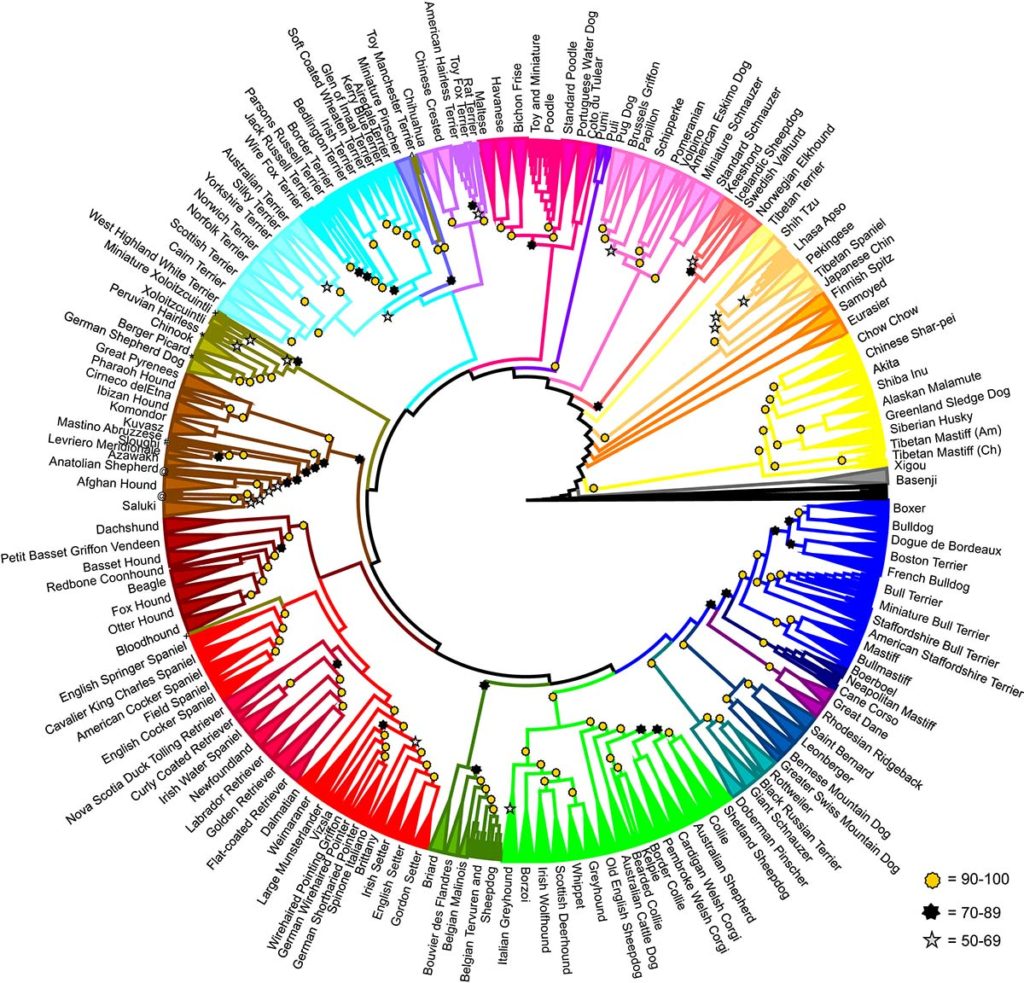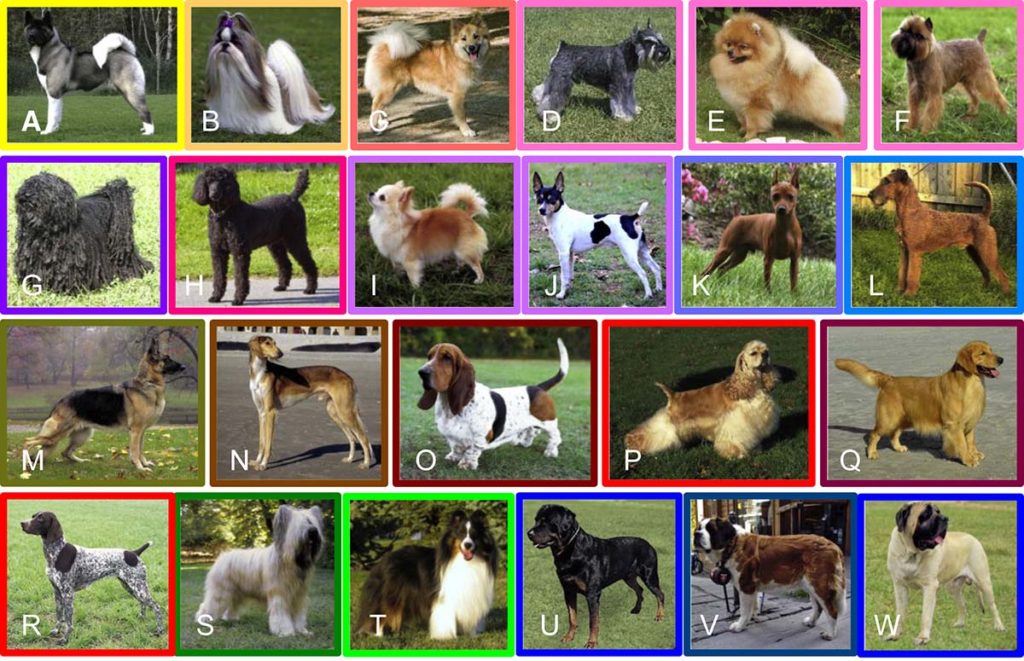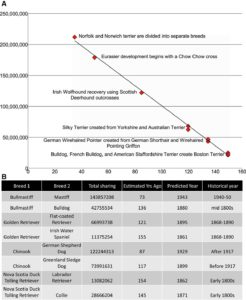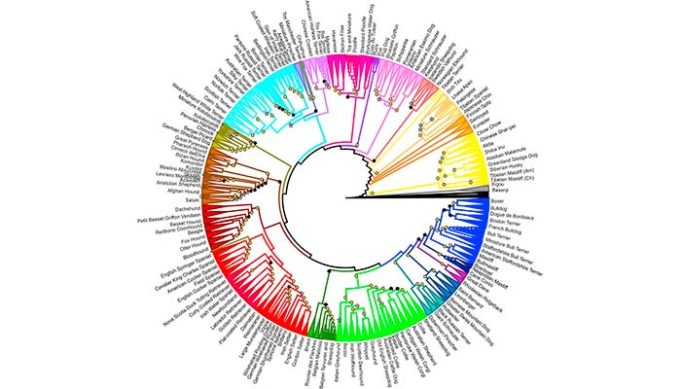Researchers are using human migration patterns to piece together information on past dog breeds which could help fight future diseases.
You ever wonder how a wolf became a Pug? The answer is “a whole lot of time and effort!”
Speaking in terms of evolutionary history, humans have been migrating across continents and all over the world for millennia, and they took their dogs with them.
Tracing the evolution of the various breeds of Canis familiaris as human migrations occur has been challenging, because there are now hundreds of dog breeds which occurred over thousands of years, all while moving along with man and being bred for certain traits.
But science has made a breakthrough in this endeavor. Researchers have used gene sequences from 161 modern breeds to produce an evolutionary tree of dogs. The results were published in Cell journal (PDF).
This map of dog breeds not only provides evidence that dogs traveled with man across the Bering land bridge, but will also likely serve to help scientists identify and combat genes responsible for diseases in both dogs and humans.
RELATED: Researchers Discover a Better Treatment for Epilepsy in Dogs

Type vs Breed in Dog Breeding
Domesticated dogs have been bred for desired traits and functions by humans perhaps almost as long as they have been our companions.
First, they started to be bred for their type – herders, pointers, etc. Then, man figured out he could breed dogs for desired physical traits, too.
Study co-author Heidi Parker, who's been studying dog's genome and the evolution of dog breeds for years, points out that understanding that types of dogs date back a lot further than breeds or physical appearances, and considers this fact very significant.
Surprising Results in the Americas
Most dog breeds found in the Americas are descendants from Europe.
However, this study uncovered evidence that some breeds from Central and South America – such as the fascinating Peruvian Hairless Dog and the Xoloitzcuintle breeds – are probably descendants of the so-called “New World Dog.” This ancient subspecies is thought to have migrated with the ancestors of Native Americans across the Bering Strait.
Science had always supposed this ancient breed existed, but this research provided the first proof of it in modern dog breeds.
The signature separation point in European and American dogs occurs in a hidden genome. Researchers are now one step closer toward discovering which genes denote New World ancestry.

Full list of representatives:
- (A) Akita/Asian spitz.
- (B) Shih tzu/Asian toy (by Mary Bloom).
- (C) Icelandic sheepdog/Nordic spitz (by Veronica Druk).
- (D) Miniature schnauzer/schnauzer.
- (E) Pomeranian/small spitz.
- (F) Brussels griffon/toy spitz (by Mary Bloom).
- (G) Puli/Hungarian.
- (H) Standard poodle/poodle.
- (I) Chihuahua/American toy.
- (J) Rat terrier/American terrier (by Stacy Zimmerman).
- (K) Miniature pinscher/pinscher.
- (L) Irish terrier/terrier.
- (M) German shepherd dog/New World (by Mary Bloom).
- (N) Saluki/Mediterranean (by Mary Bloom).
- (O) Basset hound/scent hound (by Mary Bloom).
- (P) American cocker spaniel/spaniel (by Mary Bloom).
- (Q) Golden retriever/retriever (by Mary Bloom).
- (R) German shorthaired pointer/pointer setter (by Mary Bloom).
- (S) Briard/continental herder (by Mary Bloom).
- (T) Shetland sheepdog/UK rural.
- (U) Rottweiler/drover
- (V) Saint Bernard/alpine.
- (W) English mastiff/European mastiff (by Mary Bloom)
Breed Evolution Abroad

There were some more predictable results in the study as well.
Many breeds of so-called “gun dogs” (such as the Golden Retrievers, Irish Setters, etc.) were traced back to Victorian England. Their evolution coincided with gun evolution, because their traits were useful for hunting.
These breeds, along with Spaniels, don’t have a lot of diversity occurring. This indicates that they are a more recent group of breeds.
Middle Eastern breeds (like the Saluki dog), and Asian breeds (like the Chow Chow and Akita dogs) look to have split off genetically from the rest of the pack way before the more modern Victorian era took place. So these breeds kind of separated and did their own thing, and were developed for different functions.
However, a surprising result was that the “herding breeds” from Europe are unexpectedly diverse. Because each breed had marked diversity, and this trend traces origins across most areas of Europe, it was deduced that humans were using dogs as workers not for just hundreds of years before now – but thousands.
Furthermore, this study used herding categorization to prove what was previously only suspected – that herding dogs were developed in several locations and at different times, rather than having a singular origin.
Understanding Past Dogs Helps the Future
Looking at the genetic stories of dogs has some practical applications for humans, too. Canines are oftentimes afflicted with the same diseases and disorders humans get, such as diabetes, epilepsy, kidney disease, and cancer.
Looking at these diseases from a genetic perspective reveals a lot of details in how the disease alleles travel. This allows scientists to predict where they will go next.
This is important for both dogs and humans, because every time a gene for a disease is found in a dog, it turns out to be significant for people, too.
More to Come
For this study, researcher Elaine Ostrander and her team have recruited the breeds from dog shows (where the cream of the crop in each breed can be found).
Although they recruited many breeds for their sample set, more than half the dog breeds in the world still are not accounted for in the genetic sequencing.
Researchers intend to keep collecting genomes until they fill the gaps. Who knows what other fascinating facts we’ll find out about man’s best friend along the way!
Reference:
- Heidi G. Parker, Dayna L. Dreger, Maud Rimbault, Brian W. Davis, Alexandra B. Mullen, Gretchen Carpintero-Ramirez, Elaine A. Ostrander. Genomic Analyses Reveal the Influence of Geographic Origin, Migration, and Hybridization on Modern Dog Breed Development. Cell Reports, 2017; 19 (4): 697 DOI: 10.1016/j.celrep.2017.03.079













